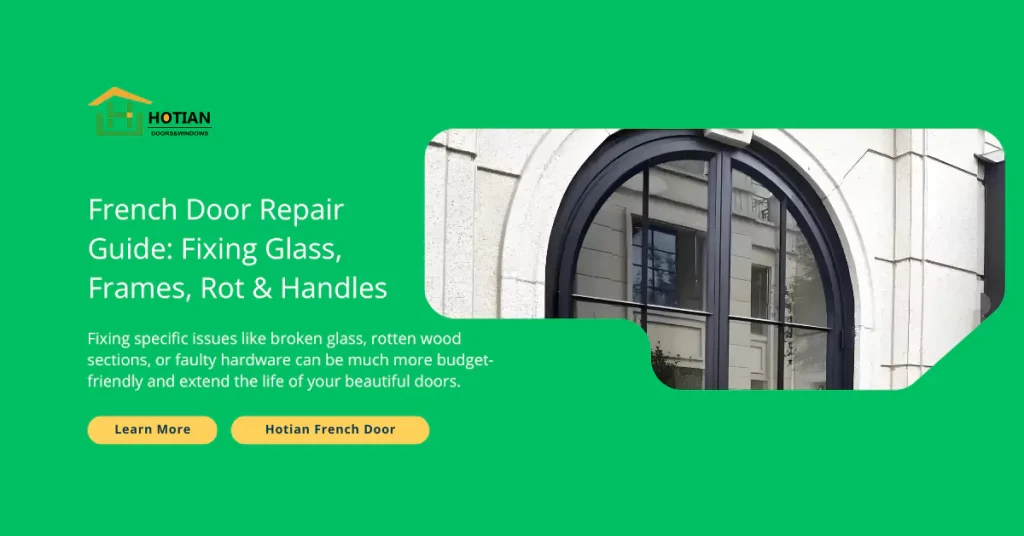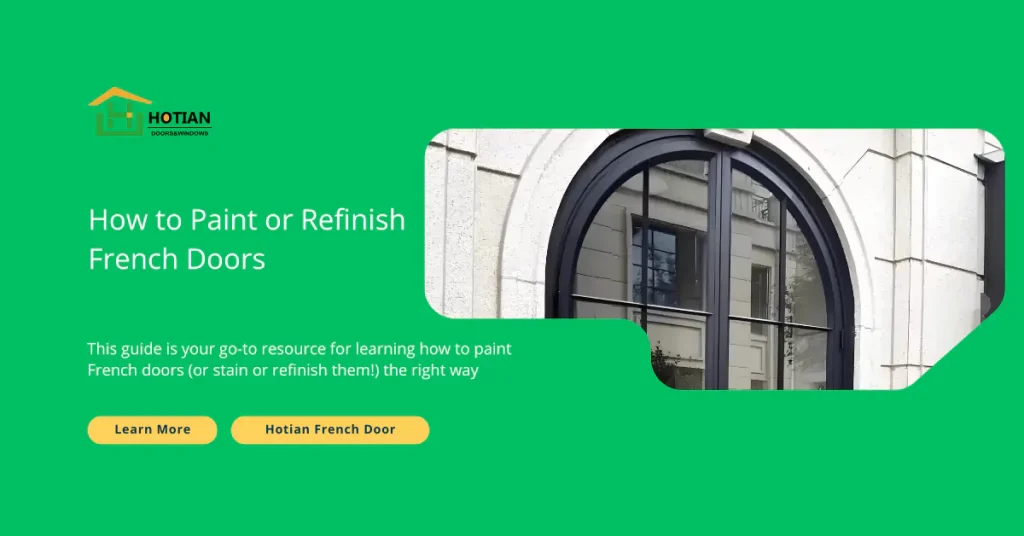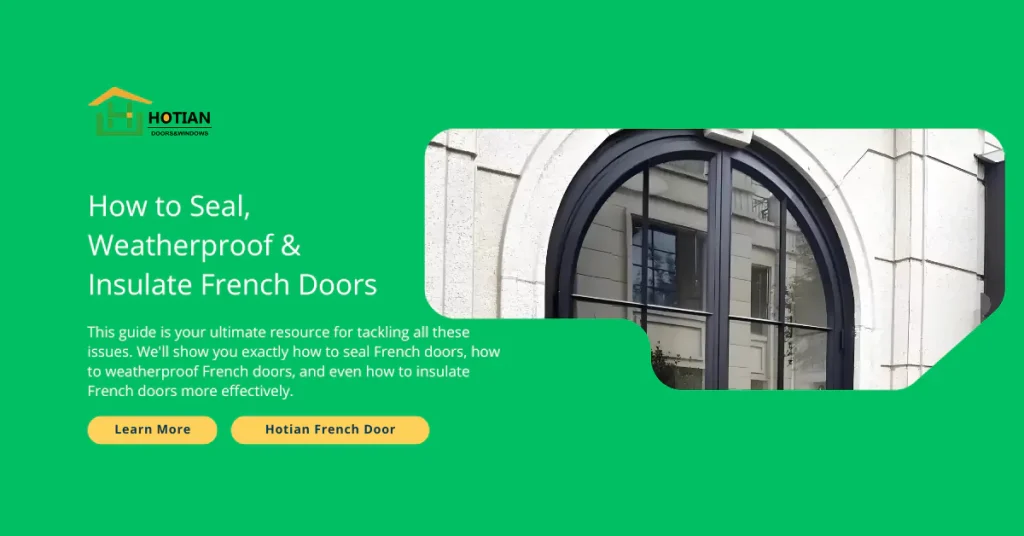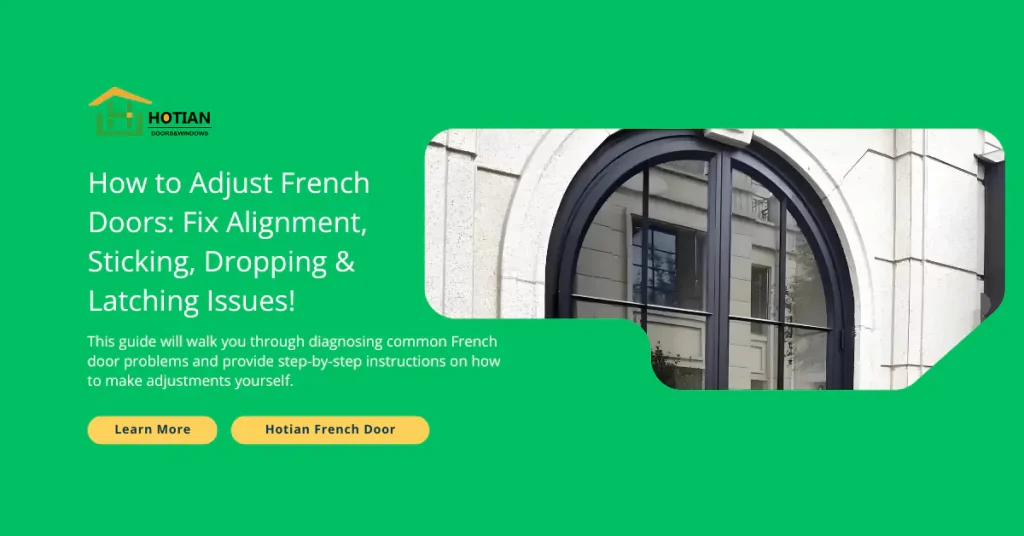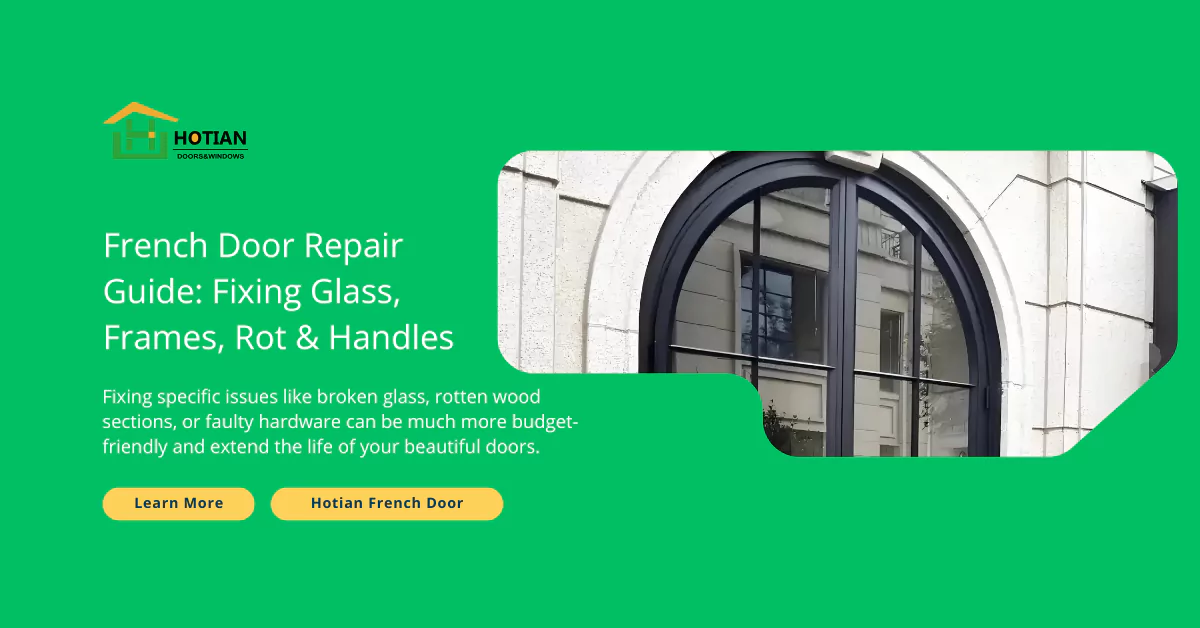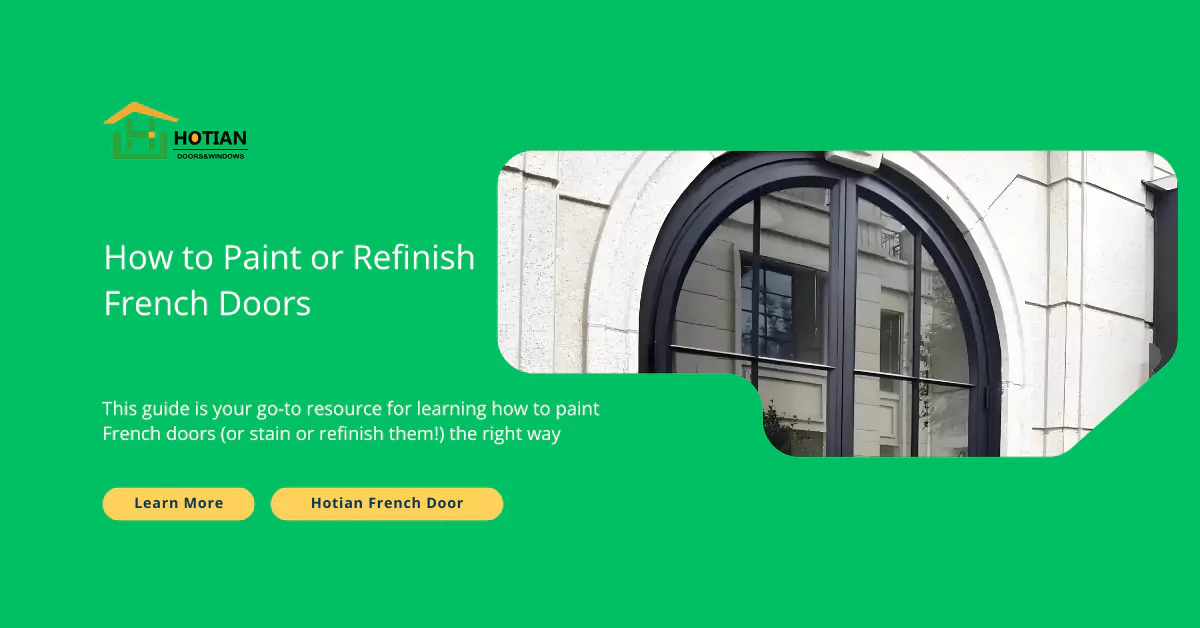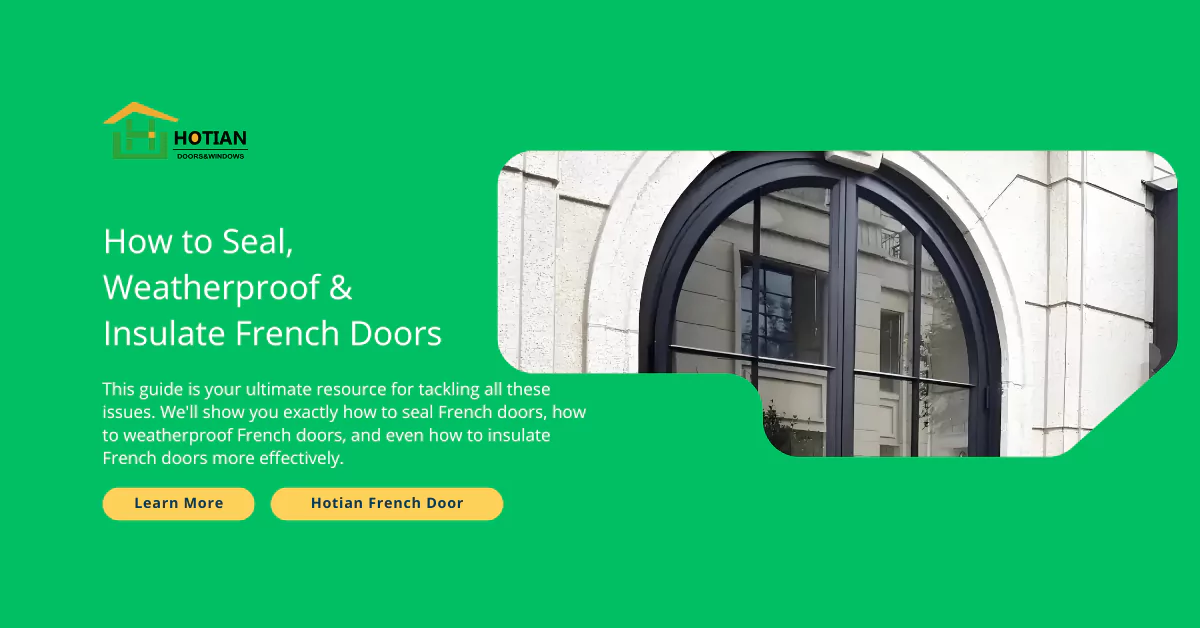French doors – aren’t they just lovely? They flood our homes with light, offer stunning views, and add a real touch of elegance. It’s no wonder they’re so popular! You can learn more about their classic appeal in What is French Doors?.
But with all that glass and those double doors meeting in the middle, it’s natural to wonder: Are French doors secure? Are they easy to break into? Unfortunately, statistics do show that patio doors, including French doors, can sometimes be targeted by burglars if not properly secured.
The good news? There are TONS of ways to make your French doors significantly more secure, often without sacrificing their beautiful appearance. You can have both style and peace of mind!
This guide is your complete resource for how to secure French doors. We’ll cover everything:
- Understanding exactly why French doors can be vulnerable.
- How to check the security of your current doors.
- Solutions for strengthening the glass.
- Upgrading locks and hardware (answering “what is the best lock for French doors?”).
- Reinforcing the frame and hinges.
- Advanced options like security systems.
- Easy DIY security fixes.
- How to lock French doors effectively in different situations.
Whether you have exterior French doors leading to the patio or even interior French doors you want to secure (like for a home office), we’ve got tips for you. Let’s dive in and learn how to make French doors safer!
Understanding French Door Vulnerabilities: Where Are the Weak Spots?
Knowing how burglars might target French doors helps us figure out the best ways to stop them. So, how do burglars break into French doors? They often look for these weaknesses:
A. Glass Pane Weaknesses: The Obvious Target?
- Fragility: Standard, older single-pane glass breaks relatively easily with force. Even standard double-pane glass isn’t designed to stop a determined intruder.
- Access to Locks: If glass panes are close to the door handle or lock, a burglar might break a small pane to reach inside and unlock the door from within. That’s a common technique.
- How They Break It: Sometimes it’s a quick, hard impact (like a rock or tool); other times, they might try to pry the glass out if the frame holding it is weak.
B. Door Frame and Hardware Vulnerabilities: Less Obvious, Still Risky!
- The Meeting Point (Astragal): Where the two door panels meet in the middle is often considered the weakest point. If the doors don’t align well or the astragal (the overlapping strip) is flimsy, it can potentially be pried open.
- Standard Locks: A single deadbolt on the main (“active”) door might not be enough. What about the second (“inactive”) door? Often, it’s only held by small slide bolts (flush bolts) at the top and bottom. Are these strong enough? Sometimes not. How do French door locks work effectively? Ideally, they secure both doors firmly to the frame.
- Hinges: Especially on outward-opening French doors (outswing), the hinge pins might be exposed on the outside. If these pins can be removed, the entire door could potentially be lifted off its hinges! Scary thought, right?
- Strike Plates: The metal plate on the door frame where the latch and deadbolt enter. Standard strike plates are often secured with short screws just into the soft wood door jamb. A strong kick can splinter the jamb and break the door open.
C. Configuration-Specific Vulnerabilities: Does Swing Matter?
- Inward-Opening Doors: Generally considered slightly harder to force open from the outside because the door stops prevent it from swinging through the frame. However, a strong kick can still target the lock/frame area. Securing french doors that open inward focuses heavily on strong locks and frames.
- Outward-Opening Doors: Can be pulled or pried at the hinges if pins are exposed. Need security hinges (non-removable pins or set screws). Securing french doors that open outward (or how to secure outswing french doors) requires attention to hinge security. Are outswing french doors safe? Yes, if properly secured!
- Sliding French Doors (Less Common Style): These have vulnerabilities similar to standard sliding doors – potential for lifting off tracks or prying locks if not well-designed.
Are French doors a security risk? They can be if standard, older, or poorly installed. But modern, well-secured French doors? Much less so!
Essential Security Assessment: Checking Your Doors
Before you buy anything, take a good look at your existing French doors.
A. Evaluating Your Current Setup:
- Installation Quality: Do the doors close smoothly and align perfectly in the middle? Are the gaps around the frame even? Poor installation (How to Install French Doors Guide shows the right way) can create weak points.
- Hardware Check:
- What kind of lock(s) do you have? Just a handle latch? A deadbolt? Is it only on one door?
- Check the inactive door. How is it secured? Are the top/bottom bolts flimsy or strong? Do they engage deeply into the frame/floor?
- Look at the strike plates. Are they heavy-duty? Are they secured with long screws (at least 2.5-3 inches) that go into the wall studs behind the jamb?
- Check the hinges. Are pins exposed (outswing)? Do they look sturdy?
- Glass Check: Is it single or double pane? Does it feel thin? Any labels indicating tempered or laminated glass? (Often etched in a corner).
- Frame/Door Condition: Is the wood solid or soft/rotted anywhere? Are there cracks near locks or hinges? Damage weakens security. Check our French Door Repair Guide if you spot issues.
B. Security Priorities by Door Location:
- Front Entry French Doors: Highest priority! These are very visible. Needs top-level security – strong locks, possibly reinforced glass, good lighting outside.
- Back Patio French Doors: Common entry point for burglars as they are often less visible from the street. Strong locks, glass security, and maybe sensors are crucial.
- Interior French Doors: Security needs vary. For a home office with sensitive documents, you might want a keyed lock. For a bedroom or bathroom, a simple privacy lock usually suffices. How can I lock my interior french door? Often a simple thumb-turn lock or slide bolt is enough.
C. Understanding Security Standards:
- Locks: Look for ANSI/BHMA Grade 1 (best) or Grade 2 (good) ratings on deadbolts.
- Impact Resistance: In hurricane zones, look for doors/glass meeting local impact codes (like Miami-Dade TAS or ASTM standards).
- Insurance: Some insurance companies offer discounts for specific security upgrades (deadbolts, alarm systems). Check with your provider.
Now that you know your potential weak spots, let’s look at solutions!
Glass Security Solutions: Seeing Clearly & Safely
Since glass is a common target, let’s start there. How to make glass French doors more secure?
Security Window Films
Clear films that hold broken glass together, making forced entry more difficult.
Glass Upgrades
Laminated security glass with plastic layer provides strong break-in resistance.
Decorative Enhancements
Security grilles or privacy films that combine protection with style.
A. Security Window Films: An Invisible Shield?
- How they work: These are clear polyester films applied to the inside surface of the glass. They don’t stop glass from breaking, but they hold the broken shards together, making it much harder and noisier for someone to get through. Think of it like strong tape holding cracked glass together.
- Pros: Relatively inexpensive DIY option, invisible, blocks UV rays.
- Cons: Won’t stop a very determined attacker indefinitely, quality varies, professional installation often gives better results than DIY. Doesn’t strengthen the glass itself, just contains it.
- Cost: DIY kits can be under $100. Pro install costs more ($5-$15 per square foot).
B. Glass Upgrade Options: Stronger Panes
- Laminated Security Glass: Like a car windshield – two pieces of glass bonded with a tough plastic layer in between. When hit, the glass cracks, but the plastic layer holds it together, providing significant resistance to entry. Excellent security option.
- Tempered Glass: Standard safety glass required in doors. It’s stronger than regular glass and shatters into small, relatively harmless pebbles instead of sharp shards. Better than basic glass, but not designed specifically to stop intruders like laminated glass.
- Impact-Resistant Glass: Often uses laminated glass (sometimes thicker layers) specifically designed and tested to withstand impacts from flying debris (hurricanes) and forced entry attempts. The top choice for high-security needs or storm zones, but also the most expensive.
Recommendation: Upgrading to laminated security glass is one of the most effective ways to secure glass French doors.
C. Decorative Security Enhancements: Style + Safety?
- Security Grilles/Bars: Metal grilles installed over the glass (inside or outside). Offer high physical protection but significantly change the look. Might feel “jail-like” to some.
- Privacy Films: Frosted or patterned films obscure the view, which can deter burglars who can’t see valuables inside. Some thicker decorative films might offer minimal shatter resistance, but don’t rely on them for significant security.
Hardware and Locking Systems: The Heart of Security
This is where you lock French doors effectively! How do French doors lock securely? It involves multiple points.
Multi-Point Locking Systems
Secures door at multiple points (top, middle, bottom) when locked, making it much harder to pry open.
Deadbolt Enhancements
Use Grade 1 or 2 deadbolts with 1-inch throw. Options include double-cylinder, high-security, or smart deadbolts.
Securing the Passive Door
Use heavy-duty flush bolts that engage at least 3/4 inch into metal strike plates in the header and floor.
A. Multi-Point Locking Systems: The Gold Standard
- How they work: Instead of just locking at the handle/deadbolt, these systems engage bolts or hooks into the frame at multiple points along the door’s edge (top, middle, bottom) when you turn the key or thumb-turn.
- Why they’re great for French Doors: They secure the door along its full height, making it much harder to pry open, especially at the vulnerable meeting point or top/bottom. Many modern, high-quality exterior French doors come with these pre-installed.
- Installation: Can sometimes be retrofitted onto existing doors, but it’s complex. Best integrated into a new door unit.
- This is often considered the BEST way to secure double French doors.
B. Deadbolt Enhancements: Bolstering the Basics
- Crucial: You absolutely need a deadbolt on your exterior French doors (on the active leaf). Ensure it’s a quality Grade 1 or 2 deadbolt with at least a 1-inch throw (how far the bolt extends).
- Double-Cylinder Deadbolt: Requires a key to lock/unlock from both inside and outside. Prevents unlocking from inside if someone breaks nearby glass. BUT, this can be a fire safety hazard if you can’t find the key in an emergency. Check local codes; they are banned in some areas for egress doors. A single-cylinder (key outside, thumb-turn inside) is standard and usually safer for quick escapes.
- High-Security Deadbolts: Brands like Medeco, Mul-T-Lock offer pick-resistant, drill-resistant cylinders for maximum lock security.
- Smart Deadbolts: Allow keyless entry (code, phone app) and remote locking/unlocking. Convenient, but ensure it has strong physical security too.
Can you put a deadbolt on French doors? Yes, absolutely essential on the active door!
C. Securing the Passive Door: Don’t Forget Door #2!
The inactive door (the one without the main handle/lock) needs to be secured firmly too. How to lock the inactive French door?
- Flush Bolts: These are the slide bolts typically installed on the edge, top, and bottom.
- Upgrade them: Standard ones can be flimsy. Replace with heavy-duty versions that have longer, thicker bolts.
- Ensure Engagement: Make sure the bolts engage deeply (at least 3/4 inch) into strong strike plates in the header (top frame) and threshold/floor. If holes are just in wood, they can fail easily. Install metal strike plates.
- Surface Bolts / Barrel Bolts: Can be added to the inside face for extra security, but might look less sleek.
- Specialized Locks: Some locks are designed specifically to secure the top/bottom of the passive door more robustly than standard flush bolts.
Key: The inactive door must be held rigidly in place for the active door’s lock to be effective.
Frame and Structural Reinforcement: Beefing Up the Surround
Even the best lock won’t help if the frame splinters easily! How to reinforce French doors? Focus on the frame and hinges.
Door Frame Reinforcement
Use oversized strike plates with 3-inch screws that anchor into wall studs. Consider metal reinforcement kits.
Hinge Security
Use security hinges with non-removable pins. Replace standard screws with 3-inch screws into studs.
Physical Barriers
Add security bars, floor-mounted barriers, or door jammers for additional physical resistance to forced entry.
A. Door Frame Reinforcement:
- Upgrade Strike Plates: Replace the standard small strike plates for your latch and deadbolt with heavy-duty, oversized ones made of thicker metal.
- Use LONG Screws: This is HUGE! Remove the short screws holding the strike plates (and hinges). Replace them with 3-inch screws that go through the door jamb and anchor firmly into the wall studs behind it. This dramatically increases resistance to kicking attacks.
- Metal Reinforcement Kits: Products like “Door Armor” or similar kits provide metal plates that wrap around the jamb in the lock and hinge areas, significantly strengthening the wood against splitting.
B. Hinge Security: Stop Removal!
- Security Hinges (for Outswing Doors): If your hinges are outside, ensure they have features preventing pin removal:
- Non-Removable Pins (NRP): The pin cannot be tapped out.
- Set Screws: A small screw locks the pin in place.
- Security Studs: A stud on one hinge leaf locks into a hole on the other when the door is closed, preventing removal even if the pin is out.
- Long Hinge Screws (All Doors): Just like with strike plates, replace at least one or two screws per hinge leaf (on the frame side) with 3-inch screws going into the wall studs. This helps prevent the entire door/frame from being forced inward.
C. Physical Barriers and Braces: Extra Muscle
These add a visible, physical block:
- Security Bars: Removable bars that brace across the inside of the doors, often fitting into brackets screwed into the frame or wall studs on either side. Very effective when in place.
- Floor-Mounted Barriers: Devices like “Nightlock” mount to the floor and slide a plate up against the bottom of the doors, preventing them from being forced open. Strong and relatively discreet when not engaged.
- Door Jammers/Barricades: Wedge-like devices placed under the handle or braced against the floor to physically stop the door from opening inward. Portable options exist too.
These are great for nighttime security or when you’re away.
Advanced Security Options: High-Tech & Heavy Duty
Want to go further?
- Security Door Overlays:
- Security Screen Doors: Strong metal mesh (steel or aluminum) doors installed outside your French doors. Allow airflow while providing a tough barrier. Can have their own robust locks.
- Decorative Security Doors: Wrought iron or steel doors installed outside, offering security with more aesthetic appeal than basic bars.
- Smart Home Integration:
- Door Sensors: Simple sensors that trigger an alarm (or phone notification) if the door is opened. Place sensors where the two doors meet or on each door relative to the frame.
- Security Cameras: Pointed at the doors (inside and/or outside) can deter burglars and record evidence.
- Smart Locks: Integrate with your smart home system for remote control and monitoring.
- Complete Security Systems: Integrate door sensors, glass break detectors, and motion sensors with a monitored alarm system for professional response.
DIY Security Solutions: Budget-Friendly Fixes
You don’t always need to spend a fortune! How to add extra security to French doors on a budget?
- Under $50 / Weekend Projects:
- Install Longer Screws: Replace strike plate and hinge screws with 3-inch screws. Biggest bang for your buck! Cost: < $10. Time: < 1 hour.
- Install a Simple Security Bar: Buy or make a sturdy wooden or metal bar to brace across the doors internally. Cost: < $30. Time: < 1 hour (if buying brackets).
- Apply Basic Security Film (DIY): Can provide some shatter resistance. Cost: ~$50+ depending on door size. Time: Few hours (requires patience!).
- Add Barrel Bolts: Install simple surface bolts on the inside top/bottom of one or both doors. Cost: < $20. Time: < 1 hour.
- Step-by-Step Basics:
- Reinforcing Strike Plate: Remove old plate. Hold new heavy-duty plate in place. Pre-drill pilot holes for long screws angled slightly towards the wall stud. Drive 3-inch screws firmly.
- Adding Secondary Lock (e.g., Surface Bolt): Choose location. Mark screw holes. Pre-drill pilot holes. Screw bolt base securely to door. Mark where bolt hits frame/floor. Install strike plate/drill hole for bolt.
- When to Call a Pro: If you’re uncomfortable drilling, dealing with complex locks (multi-point), integrating alarms, or reinforcing frames significantly, call a qualified locksmith or security professional.
Security for Special Situations
- Hurricane/Storm Zones: Impact-resistant doors/glass are key. Storm bars or plywood covers are temporary measures. How to secure French doors for hurricane? Follow local building codes for impact protection!
- Vacation Homes: Smart locks for remote access control, security cameras, monitored alarms, and maybe asking a neighbor to keep an eye out are good ideas. Ensure all basic reinforcements (long screws, good locks) are done.
- Emergency Egress: Crucial! Security measures should NOT trap you inside during a fire. Avoid double-cylinder deadbolts on main exit doors. Ensure any security bars or braces can be quickly removed from the inside without a key or special tools. Practice emergency plans with your family.
Comparative Analysis of Security Options
How do you choose?
- Cost-Benefit: Longer screws = highest value for lowest cost. Laminated glass = excellent security but higher cost. Monitored alarm = ongoing cost but professional response. Balance your budget with the level of risk/peace of mind desired. Upgrades might lead to small insurance discounts.
- Aesthetic Impact: Security film is invisible. Reinforced strike plates are hidden. Security bars/grilles are visible. Choose what fits your home’s look and your comfort level. High-quality hardware often looks better too. Want stylish doors from the start? Explore options like ours here!
- Security Levels:
- Basic Deterrence: Good lighting, visible locks, maybe a security sign/sticker.
- Moderate Security: Upgraded deadbolt, long screws, security film, reinforced passive door bolts. Good for most homes.
- Maximum Protection: Multi-point lock, laminated/impact glass, reinforced frame, security system, potentially security screens/doors. For high-risk areas or maximum peace of mind.
Product Reviews and Recommendations (Examples – Always research current models!)
- Security Films: Brands like 3M Scotchshield, BDF, Armorcoat are well-known. Look for thickness (8 mil+ often recommended for security).
- Locks/Hardware: Schlage, Kwikset (SmartKey feature debated), Medeco, Mul-T-Lock offer various grades. For multi-point, check systems integrated by door manufacturers like Andersen, Pella, Marvin, or specialized aftermarket brands if retrofitting.
- Reinforcement Kits: Door Armor MAX Combo Set is a popular example. Search for “door frame reinforcement kit.”
- Floor Barriers: Nightlock Lockdown or Original are common examples.
Disclaimer: These are examples, not endorsements. Research current reviews and products.
Maintenance and Long-Term Security
Security isn’t “set it and forget it”!
- Regular Checks (Monthly/Seasonally):
- Wiggle door handles/locks – are they tight?
- Test deadbolt operation – smooth? Fully extends?
- Check flush bolt engagement – secure?
- Inspect strike plates/hinges – screws tight? Any cracks in wood?
- Look at exterior caulk/seals – intact?
- Test alarm sensors/cameras if you have them.
- Upgrading: Re-evaluate security every few years. Are there new threats or technologies? Is your hardware wearing out?
- Habits: Lock doors every time, even if home or leaving for a minute! Use security bars/braces at night or when away. Trim bushes near doors (hiding spots). Use exterior lighting.
Conclusion: Layer Up for Peace of Mind
Are French doors secure? They absolutely can be! While standard versions might have weaknesses, securing them effectively is achievable through a layered approach. Don’t rely on just one thing!
Key Principles:
- Strengthen the Glass: Use security film or upgrade to laminated/impact glass.
- Upgrade the Locks: Use a quality deadbolt (Grade 1/2) AND secure the passive door firmly (heavy-duty flush bolts or multi-point system).
- Reinforce the Frame: Use long screws (3 inches!) in strike plates and hinges, anchoring into wall studs. Consider reinforcement kits.
- Secure the Hinges: Especially important for outswing doors (use security hinges).
- Consider Extra Layers: Security bars, floor braces, alarms, cameras add further protection.
By addressing the potential vulnerabilities in the glass, hardware, and frame, you can confidently enjoy the beauty and light of your French doors without compromising your home’s safety.
Looking for new French doors with modern security features built-in? Check out our selection of high-quality, customizable French doors designed for both beauty and security. We can help you find the perfect, safe addition to your home!

